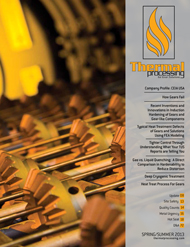In the last issue of Thermal Processing, I wrote a pretty broad and general article about the do's and dont’s of safety, using some examples of accidents I knew about. This time, I’d like to pick a specific topic and get into a little more depth.
“Lock-Out Tag-Out”
In my heat treating facilities—I was senior general manager of two—we had very good accident-prevention programs. At one of the facilities, we had an eight-year run of no “lost time” accidents; any accident resulting in a lost day of work for the employee. We had a few close calls with minor cuts and bruises, but overall the programs in place, when followed, worked. One of the incentives implemented was this: For every year without a lost time accident, we would give each employee $100. We ended up capping it at $500, but the savings to the company in lost time wages and insurance premiums far exceeded the cost.
What does a lock-out tag-out system do?
It keeps one person responsible and in control of the power to a piece of equipment that is out of service. Most equipment uses cylinders, valves, mechanical gears, and levers driven by electric or air and hydraulic motors. With this program, you have a way to keep your employees safe while the equipment is locked out and tagged out.
When do you have to use it?
While performing any kind of maintenance, if the piece of equipment needs its guards removed for visual inspection, or in the event of a malfunction. In my last article, I told the tragic story of two men who died in a preventable accident, had the proper lock-out tag-out safety procedures been used.
Why do you do it?
It is invaluable anytime you pose a risk of electrocution, fire or explosion, asphyxiation, burns or spill hazards, or movement of mechanical valves and cylinders resulting in pinching and/or crushing.
What needs to be “locked out?”
Every piece of equipment that has some type of safety hazard associated with its operation and maintenance, from a simple copy machine (unplug it before servicing any electrical or pinch hazard) to large heat treating furnaces, air compressors, induction machines, vacuum furnaces, car bottom furnaces, open-fire furnaces, transfer carts, and overhead cranes. These all use many different types of power to move the product in, out, and around the shop. In the furnaces, you have fans for circulation of the atmospheres, motors for circulation of oil and water, opening and closing of doors and valves, and very high-pressure hydraulic fluid for cylinders and hydraulic motors. You might also have high-pressure air, nitrogen, argon, endothermic, exothermic, ammonia, hydrogen, helium, hot quench oil, and hot and cold cooling water.
What needs to be “tagged-out”?
When a piece of equipment is properly locked out, the valve or electrical switch is in the “off” position, with a repair tag and a special device that makes it impossible to open or turn back on without removing a lock with a key. You should have some kind of sign out sheet with a description of who signed out the lock, tag, and the equipment number. This person keeps control of the key to the lock.
While this repair is done, there is no way anyone else can turn on the equipment by accident. Most accidents involving crushing or pinching of arms and legs result from accidental activation of quench elevators and furnace doors; the air pressure or hydraulics are activated by someone turning them on while the person is inside the equipment. Electrical shocks occur the same way. When lock-out tag-out is used properly, the operator and maintenance personnel are aware of someone doing repair. While inside the equipment, you are required to have a spotter watching outside. When I was in maintenance, I made it a habit of not only turning off a valve for the different gasses but also disconnecting the service line after the valve, in case it was leaking through. This is a good procedure and should be part of the repair procedures.




































